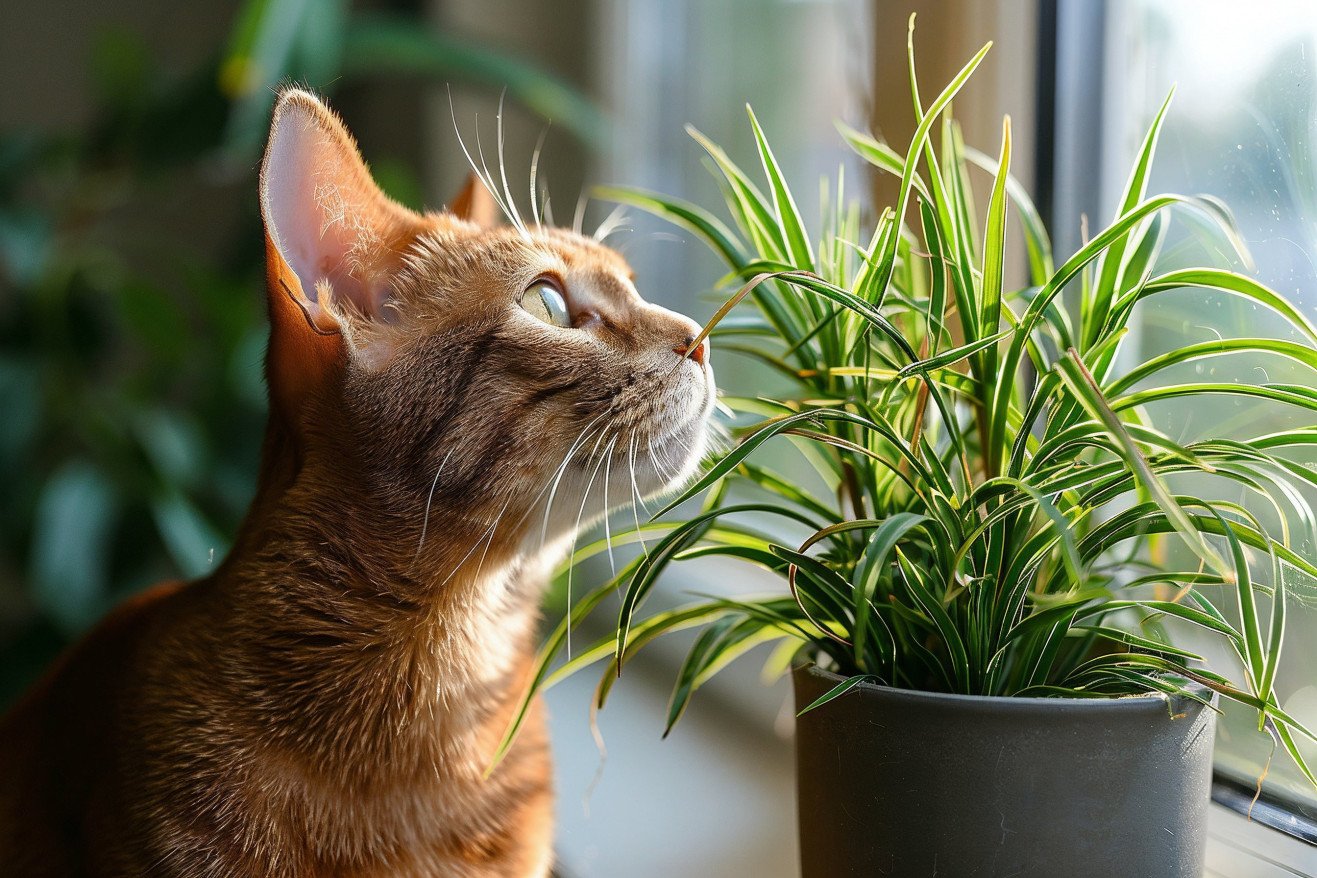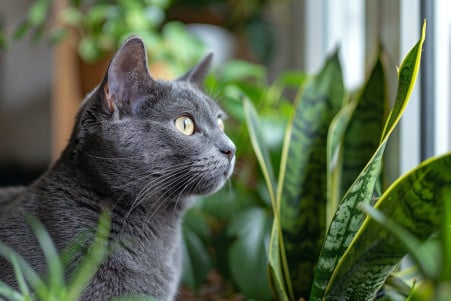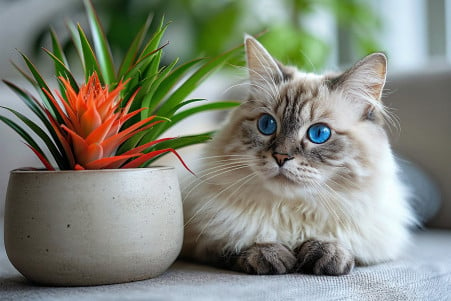Can Cats Eat Spider Plants? Toxicity and Other Safe Houseplants
20 February 2024 • Updated 21 February 2024

If you have a cat, you may have wondered about the safety of the plants in your home, especially if you have a spider plant. While spider plants (Chlorophytum comosum) are not poisonous to cats, they are listed as non-toxic by the ASPCA. That said, if a cat consumes a large amount of spider plant leaves, it can lead to some mild gastrointestinal upset like vomiting or diarrhea.
This article will review a number of botanical and veterinary studies to determine the safety of popular houseplants for cats, including spider plants. It will also look at the biological impact of plant consumption in cats, why cats eat plants, and what you can do to make sure your cat stays safe.
By the end of this article, you should have a good understanding of what you can do to make sure your cat is safe and happy in your home.
Are spider plants poisonous to cats?
Spider Plant Toxicity
Spider plants (Chlorophytum comosum) have become known for their chemical makeup, but they are not toxic. According to Gardening Know How, the plants have compounds that are similar to those in opium, which can cause some minor gastrointestinal upset in cats if they are eaten.
However, the American Society for the Prevention of Cruelty to Animals (ASPCA) has confirmed that spider plants are non-toxic to cats. The symptoms that cats may experience, like vomiting or diarrhea, are mild and not common.
The Wildest points out that studies, including one from NASA, have shown that spider plants are good at purifying the air, which further proves that they are safe.
While there is a lack of detailed data on how often cats experience gastrointestinal upset from eating spider plants, especially when compared to other plants, cat owners should still monitor their cats for any signs of distress after they have eaten one.
If cats experience prolonged vomiting or any other symptoms that seem out of the ordinary, like a change in behavior, they should be taken to the vet. Cat owners should take this information about spider plant toxicity into account to make sure their cats are safe and stimulated in their environmenta balance that also takes into account the fact that cats are naturally curious and will want to explore plants.
Why Cats Are So Drawn to Spider Plants
The appeal of spider plants to cats is a mystery, but it seems to be rooted in their natural behaviors. Pet Health Network explains that when cats eat plants, it may be an attempt to experience a different texture or to get the sensation of fiber, even though they are obligate carnivores.
The long, thin, dangling leaves of the spider plant that move and sway with the slightest breeze are similar to the way prey might move, which can stimulate a cat’s hunting instincts.
Some have even suggested that spider plants may cause cats to experience a mild high, which could explain why cats seem to be affected by them in the same way they are by catnip, but this has not been proven.
Cats are also naturally curious and seek out new experiences, which the spider plant can easily provide due to its unusual appearance and texture. Vetstreet explains that cats’ interactions with plants like spider plants can also be due to psychological and nutritional reasons, such as trying to relieve discomfort from digestive problems or trying to get certain nutrients.
Knowing these natural behaviors and attractions can help cat owners better plan their living spaces to meet their cats’ needs for both mental stimulation and safety. This may involve providing safe plants like cat grass or figuring out ways to keep appealing but potentially dangerous plants out of a cat’s way.
Creating a Cat and Plant Friendly Space
If you’re a cat owner who loves your houseplants, it’s important to make sure that your plants and your pets can coexist safely. As The Spruce points out, hanging planters are a great way to keep spider plants and other houseplants away from your cat. This easy solution can keep your cat from taking a bite that could make them sick.
It’s also important to know which houseplants are toxic to cats, and the ASPCA’s list of plants that are safe for cats is a great place to start.
To further cat-proof your home, Gardening Know How recommends using bitter sprays on the leaves of your plants or using physical barriers like aluminum foil at the base to keep cats away. You can also make sure your cat has access to other plants, like cat grass or catnip, that they can chew on to keep them away from your houseplants.
By doing this, you can make sure that your pets and your indoor garden stay safe. With a little creativity and effort, you can ensure that your cats and your houseplants can coexist peacefully.
Comparing the Safety of Spider Plants to Other Common Houseplants
If you’re considering getting a houseplant and you have a cat, it’s important to understand how different plants compare in terms of their toxicity. A study in PMC shows that spider plants are non-toxic and safe for cats, which is in contrast to other common houseplants like lilies and sago palms, which are toxic to cats and can cause acute renal failure and liver damage, respectively.
In addition, other houseplants like dieffenbachia and philodendrons, which contain oxalate crystals and other toxic compounds, can cause a range of symptoms in cats from oral irritation to kidney failure. Meanwhile, a study in Toxins shows that indoor plants like oleanders and cyclamen can cause symptoms in cats from gastrointestinal upset to cardiac issues and death.
Spider plants are one of the few plants that are both good for air purification and safe for pets. This information from the studies in PMC and Toxins is important for pet owners to consider. By choosing spider plants, cat owners can make sure their home has clean, healthy air without putting their pets at risk, and that’s a good example of how to make responsible plant choices in a home with pets.
Cultivating a Pet-Friendly Green Space: A Summary
From the above, we can see that spider plants are a great way to add both style and air-purifying power to your home without worrying about your cat’s safety. The ASPCA has deemed them non-toxic, so cat owners can rest easy, even though cats may experience some minor stomach upset if they eat them in large amounts.
That said, it’s important to watch your cat around your houseplants, as doing so will help ensure their continued health and happiness.
By making thoughtful plant choices, you can enjoy the benefits of greenery in your home while keeping your pets safe. In doing so, you’ll make sure that you’re creating an environment that’s healthy and enjoyable for everyone in your home, including your furry friends.
Let’s take these lessons to heart and create spaces that allow cats to explore their natural curiosity while also giving us the chance to enjoy the calming presence of houseplants in our homes, allowing for a happy coexistence.


